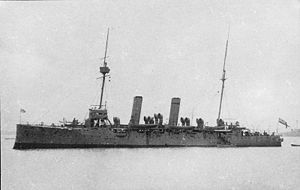Eclipse class cruiser

HMS Talbot
|
|
| Class overview | |
|---|---|
| Name: | Eclipse class |
| Operators: |
|
| Preceded by: | Astraea class |
| Succeeded by: | Arrogant class |
| Built: | 1893–1898 |
| In commission: | 1897–1921 |
| Completed: | 9 |
| Scrapped: | 9 |
| General characteristics | |
| Type: | Protected cruiser |
| Displacement: | 5,600 long tons (5,690 t) |
| Length: | 350 ft (106.7 m) |
| Beam: | 53 ft 6 in (16.3 m) |
| Draught: | 20 ft 6 in (6.25 m) |
| Installed power: | |
| Propulsion: | 2 shafts, 2 Inverted triple-expansion steam engines |
| Speed: | 18.5 knots (34.3 km/h; 21.3 mph) |
| Complement: | 450 |
| Armament: |
|
| Armour: |
|
The Eclipse-class cruisers were a class of nine second-class protected cruisers constructed for the Royal Navy in the mid-1890s.
These ships were enlarged and improved versions of the preceding Astraea class. The Eclipse-class ships were 373 feet (113.7 m) long overall, had a beam of 53 feet 6 inches (16.31 m) and a draught of 20 feet 6 inches (6.2 m). They displaced 5,600 long tons (5,700 t) at normal load. To reduce biofouling, the hulls of the ships were sheathed with wood and copper. Their crew consisted of 450 officers and enlisted men. Their metacentric height was approximately 3 feet (0.9 m).
The Eclipse-class ships were powered by two inverted triple-expansion steam engines using steam generated by eight cylindrical boilers at a pressure of 155 psi (1,069 kPa; 11 kgf/cm2). Using normal draught, the boilers were intended to provide the engines with enough steam to generate 8,000 indicated horsepower (6,000 kW) and to reach a speed of 18.5 knots (34.3 km/h; 21.3 mph); using forced draft, the equivalent figures were 9,600 indicated horsepower (7,200 kW) and a speed of 19.5 knots (36.1 km/h; 22.4 mph). During their sea trials, all of the lightly loaded ships exceeded their specifications and reached a top speed of 20 knots (37 km/h; 23 mph). They carried a maximum of 1,075 long tons (1,092 t) of coal.
The ships carried five 40-calibre 6-inch (152 mm) quick-firing (QF) guns in single mounts protected by gun shields. One gun was mounted on the forecastle, two on the quarterdeck and one pair was abreast the bridge. They fired 100-pound (45 kg) shells at a muzzle velocity of 2,205 ft/s (672 m/s). The secondary armament consisted of six 40-calibre 4.7-inch (120 mm) guns; three on each broadside. Their 45-pound (20.4 kg) shells were fired at a muzzle velocity of 2,125 ft/s (648 m/s).
...
Wikipedia
